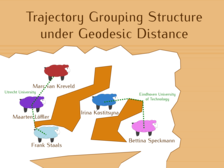
Trajectory Grouping Structure under Geodesic Distance
Proc. 31th Annual Symposium on Computational Geometry, 2015
@inproceedings{geogrouping2015,
author = {Kostitsyna, Irina and van Kreveld, Marc and L{\"o}ffler, Maarten and
Speckmann, Bettina and Staals, Frank},
title = {Trajectory Grouping Structure under Geodesic Distance},
booktitle = {Proc. 31th Annual Symposium on Computational Geometry},
year = {2015},
location = {Eindhoven, The Netherlands},
numpages = {15},
keywords = {trajectories, grouping, moving entity, geodesic distance},
category = {trajectories},
pages = {674--688},
series = {Leibniz International Proceedings in Informatics (LIPIcs)},
isbn = {978-3-939897-83-5},
issn = {1868-8969},
volume = {34},
publisher = {Schloss Dagstuhl--Leibniz-Zentrum fuer Informatik},
url = {https://dx.doi.org/10.4230/LIPIcs.SOCG.2015.674},
doi = {10.4230/LIPIcs.SOCG.2015.674},
}